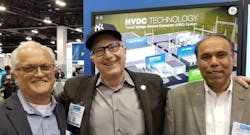Theory Explained: Thinking about the Digital Power Grid
I started out this month’s "Digital Innovations" newsletter talking about the Denver T&D Expo and all the digital technology on display throughout the exhibition hall, so I’m going to continue. Let’s look at some ideas on new theories and how to get your mind around this digital grid we find ourselves enmeshed in. I found digital technologies running from the extremely simple to the brain-numbing complex and just about everything in between on the exhibition floor. If you are like me, you might find yourself drawn to the more complicated of the topics no matter how daunting it might be. We all have an area of expertise and other areas that just plain interest us, but how do you get more of an insight into these topics without taking a chance. I like jumping into the deep end and seeing what happens.
These complicated subjects are the ones that grab you from the get-go, but are not directly related to your day job. In college they called these topics enrichment subjects, but there is a strange phenomenon associated with enrichment subjects. They sometimes can become your main interest as you learn more about the topic. That is where an event like a trade show becomes valuable. The exhibitors bring a great deal of expertise to the event and those experts are excited to talk to people about their passion, which can be infectious.
While wandering around the exhibition floor I talked to Tobias Tepe one of Siemens’ engineers who had been on the team that developed a totally mobile static VAR compensator (SVC) to give utilities more versatility when it came to reinforcing their system. I met an old friend Dan Sullivan from Mitsubishi. He was excited over Mitsubishi’s building block approach to IGBT valve technology that was being used in their STATCOMs, SVCs, and HVDC projects. An ABB engineer I ran into was excited about his project that resulted in the first digitally integrated power transformer. At the GE exhibit, I ran into GE’s HVDC authority Neil Kirby talking with PES HVDC wizard Mike Henderson and EPRI’s HVDC guru Ram Adapa. They were running through the GE HVDC computer simulation for HVDC.
I could go on for many pages about the experts I talked to at the Expo, but I’m sure you get the idea. The one common denominator all for these folks represented was their excitement over some digital attribute of the digital grid and their willingness to explain the theories behind those digital characteristics in as much detail as needed to increase the listener’s understanding. These were the types of encounters that are so important for an engineer, technician, or executive. They give them the chance to expand their horizons into new waters of the smart grid and the theory behind those topics in as much time as the listener has available. I came back to my office with lots of new ideas and have been surfing specific information to increase my appreciation of these new ideas.
About the Author
Gene Wolf
Technical Editor
Gene Wolf has been designing and building substations and other high technology facilities for over 32 years. He received his BSEE from Wichita State University. He received his MSEE from New Mexico State University. He is a registered professional engineer in the states of California and New Mexico. He started his career as a substation engineer for Kansas Gas and Electric, retired as the Principal Engineer of Stations for Public Service Company of New Mexico recently, and founded Lone Wolf Engineering, LLC an engineering consulting company.
Gene is widely recognized as a technical leader in the electric power industry. Gene is a fellow of the IEEE. He is the former Chairman of the IEEE PES T&D Committee. He has held the position of the Chairman of the HVDC & FACTS Subcommittee and membership in many T&D working groups. Gene is also active in renewable energy. He sponsored the formation of the “Integration of Renewable Energy into the Transmission & Distribution Grids” subcommittee and the “Intelligent Grid Transmission and Distribution” subcommittee within the Transmission and Distribution committee.
